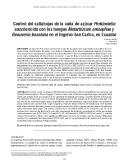| dc.description.abstract | La cigarrita Perkinsiella saccharicida es una de las plagas más importantes en el cultivo de la caña de azúcar en el Ecuador. El adulto y las ninfas se alimentan de las hojas succionando líquidos, lo cual provoca retardo en el crecimiento. El objetivo de este trabajo fue evaluar la patogenicidad en laboratorio y campo de cinco aislamientos de Metarhizium anisopliae y uno de Beauveria bassiana en adultos y ninfas. Se sembraron plantas de caña en baldes plásticos y se protegieron con una jaula recubierta con tul. Se utilizó una dosis de 8,33 x 10 exponente 9 conidios/jaula para cada uno de los aislamientos. Se realizaron recuentos de mortalidad diaria hasta los 30 días, colocando los insectos muertos en cajas individuales, provistas de papel filtro húmedo. Los aislamientos más patogénicos de M. anisopliae (ECUSC-0192 y DIECA-0391) y el 447 de B. bassiana fueron seleccionados para el bioensayo de campo. En esta condición, el porcentaje de mortalidad para adultos y ninfas fue: ECUSC-0192 (73,8 y 52,5), 447 (62,8 y 63,6), DIECA-0391 (36,9 y 11,3) y el testigo (0,18 y 0,6). Los mejores tratamientos fueron el ECUSC-0192 y el 447. En el verano, el aislamiento VALDEZ 01-94 fue la más eficiente cuando se realizaron aplicaciones nocturnas. Se concluye que los aislamiento ECUSC-0192 y Valdez-0194 de M. anisopliae, y el 447 de B. bassiana, son efectivos para el control de P. saccharicida en el campo cuando se presentan condiciones favorables de humedad. The leaf hopper P. saccharicida is one of the most important sugar cane pests. Both adults and nymphs feed on young leaves by siphoning the liquids, provoking a retarded growth in the plants. The objective of this study was to evaluate the pathogenicity of five isolates of M. anisopliae and one of B. bassiana on the adult and nymph stages, in greenhouse and field conditions. Sugar cane plants were planted in plastic buckets and covered with a cage wrapped in a fine net. Doses of 8.33 x 10 exponent 9 conidia/cage were used for each of the isolations. Mortality counts were carried out daily, for 30 days, placing the dead insects in individual cages with moist filter paper. The isolates ECUSC-0192 and DIECA-0391 of M. anisopliae and 447 of B. bassiana were used for the field trial. In the field experiment, the mortality percentage for adults and nymphs with each isolate was: ECUS 0192 (73.8 and 52.5), 447 (62.8 and 63.6), DIECA 0391 (36.9 and 11.3), and the control (0.18 and 0.6). There were significant differences between the isolates and the control. With these results, it was concluded that the isolates ECUSC-0192 and 447 are promising for the control of P. saccharicida in the field, under conditions of high humidity. | es_ES |


